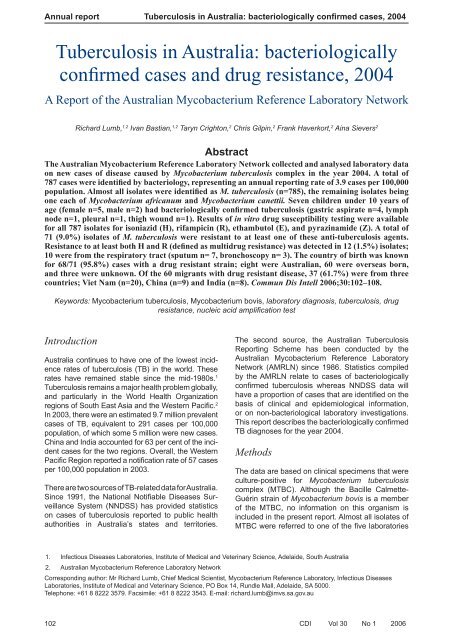PDF file - Department of Health and Ageing
PDF file - Department of Health and Ageing
PDF file - Department of Health and Ageing
You also want an ePaper? Increase the reach of your titles
YUMPU automatically turns print PDFs into web optimized ePapers that Google loves.
Annual report Tuberculosis in Australia: bacteriologically confirmed cases, 2004<br />
Tuberculosis in Australia: bacteriologically<br />
confirmed cases <strong>and</strong> drug resistance, 2004<br />
A Report <strong>of</strong> the Australian Mycobacterium Reference Laboratory Network<br />
Richard Lumb, 1,2 Ivan Bastian, 1,2 Taryn Crighton, 2 Chris Gilpin, 2 Frank Haverkort, 2 Aina Sievers 2<br />
Abstract<br />
The Australian Mycobacterium Reference Laboratory Network collected <strong>and</strong> analysed laboratory data<br />
on new cases <strong>of</strong> disease caused by Mycobacterium tuberculosis complex in the year 2004. A total <strong>of</strong><br />
787 cases were identified by bacteriology, representing an annual reporting rate <strong>of</strong> 3.9 cases per 100,000<br />
population. Almost all isolates were identified as M. tuberculosis (n=785), the remaining isolates being<br />
one each <strong>of</strong> Mycobacterium africanum <strong>and</strong> Mycobacterium canettii. Seven children under 10 years <strong>of</strong><br />
age (female n=5, male n=2) had bacteriologically confirmed tuberculosis (gastric aspirate n=4, lymph<br />
node n=1, pleural n=1, thigh wound n=1). Results <strong>of</strong> in vitro drug susceptibility testing were available<br />
for all 787 isolates for isoniazid (H), rifampicin (R), ethambutol (E), <strong>and</strong> pyrazinamide (Z). A total <strong>of</strong><br />
71 (9.0%) isolates <strong>of</strong> M. tuberculosis were resistant to at least one <strong>of</strong> these anti-tuberculosis agents.<br />
Resistance to at least both H <strong>and</strong> R (defined as multidrug resistance) was detected in 12 (1.5%) isolates;<br />
10 were from the respiratory tract (sputum n= 7, bronchoscopy n= 3). The country <strong>of</strong> birth was known<br />
for 68/71 (95.8%) cases with a drug resistant strain; eight were Australian, 60 were overseas born,<br />
<strong>and</strong> three were unknown. Of the 60 migrants with drug resistant disease, 37 (61.7%) were from three<br />
countries; Viet Nam (n=20), China (n=9) <strong>and</strong> India (n=8). Commun Dis Intell 2006;30:102–108.<br />
Keywords: Mycobacterium tuberculosis, Mycobacterium bovis, laboratory diagnosis, tuberculosis, drug<br />
resistance, nucleic acid amplifi cation test<br />
Introduction<br />
Australia continues to have one <strong>of</strong> the lowest incidence<br />
rates <strong>of</strong> tuberculosis (TB) in the world. These<br />
rates have remained stable since the mid-1980s. 1<br />
Tuberculosis remains a major health problem globally,<br />
<strong>and</strong> particularly in the World <strong>Health</strong> Organization<br />
regions <strong>of</strong> South East Asia <strong>and</strong> the Western Pacific. 2<br />
In 2003, there were an estimated 9.7 million prevalent<br />
cases <strong>of</strong> TB, equivalent to 291 cases per 100,000<br />
population, <strong>of</strong> which some 5 million were new cases.<br />
China <strong>and</strong> India accounted for 63 per cent <strong>of</strong> the incident<br />
cases for the two regions. Overall, the Western<br />
Pacific Region reported a notification rate <strong>of</strong> 57 cases<br />
per 100,000 population in 2003.<br />
There are two sources <strong>of</strong> TB-related data for Australia.<br />
Since 1991, the National Notifi able Diseases Surveillance<br />
System (NNDSS) has provided statistics<br />
on cases <strong>of</strong> tuberculosis reported to public health<br />
authorities in Australia’s states <strong>and</strong> territories.<br />
The second source, the Australian Tuberculosis<br />
Reporting Scheme has been conducted by the<br />
Australian Mycobacterium Reference Laboratory<br />
Network (AMRLN) since 1986. Statistics compiled<br />
by the AMRLN relate to cases <strong>of</strong> bacteriologically<br />
confi rmed tuberculosis whereas NNDSS data will<br />
have a proportion <strong>of</strong> cases that are identifi ed on the<br />
basis <strong>of</strong> clinical <strong>and</strong> epidemiological information,<br />
or on non-bacteriological laboratory investigations.<br />
This report describes the bacteriologically confi rmed<br />
TB diagnoses for the year 2004.<br />
Methods<br />
The data are based on clinical specimens that were<br />
culture-positive for Mycobacterium tuberculosis<br />
complex (MTBC). Although the Bacille Calmette-<br />
Guérin strain <strong>of</strong> Mycobacterium bovis is a member<br />
<strong>of</strong> the MTBC, no information on this organism is<br />
included in the present report. Almost all isolates <strong>of</strong><br />
MTBC were referred to one <strong>of</strong> the fi ve laboratories<br />
1. Infectious Diseases Laboratories, Institute <strong>of</strong> Medical <strong>and</strong> Veterinary Science, Adelaide, South Australia<br />
2. Australian Mycobacterium Reference Laboratory Network<br />
Corresponding author: Mr Richard Lumb, Chief Medical Scientist, Mycobacterium Reference Laboratory, Infectious Diseases<br />
Laboratories, Institute <strong>of</strong> Medical <strong>and</strong> Veterinary Science, PO Box 14, Rundle Mall, Adelaide, SA 5000.<br />
Telephone: +61 8 8222 3579. Facsimile: +61 8 8222 3543. E-mail: richard.lumb@imvs.sa.gov.au<br />
102 CDI Vol 30 No 1 2006
















